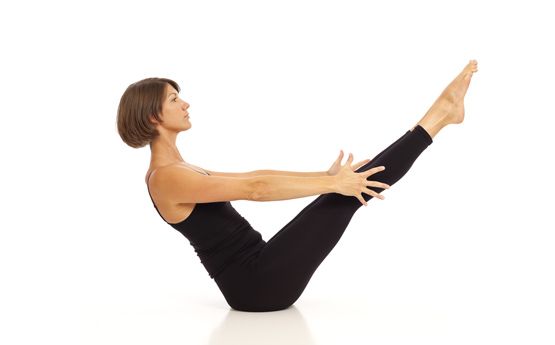Navasana : Boat Pose
Navasana, more commonly known as the Boat Pose, is a fundamental asana in many yoga practices. The name originates from Sanskrit, where “Nava” means boat and “Asana” means pose, aptly describing the shape the body resembles when performing this exercise. This ancient pose is revered for its ability to strengthen the core, improve balance, and enhance focus. In the realm of yoga, Navasana is not just a physical posture; it is a journey of discovery, aligning the mind, body, and spirit.

Benefits of Navasana
The Boat Pose, while seemingly straightforward, packs a multitude of benefits that extend across the physical, mental, and emotional spectrum. Let’s dive into how Navasana can be a transformative element of your yoga practice.
Physical Benefits
- Core Strength: Navasana is renowned for its ability to build core strength. The pose requires you to balance on your sitting bones and tailbone, engaging the abdominal muscles deeply. This engagement strengthens the core, which is vital for overall stability and balance.
- Hip Flexor and Spine Strengthening: Alongside the core, the hip flexors and spine receive a significant workout. Maintaining the pose promotes spinal alignment and strengthens the muscles around the spine.
- Improved Digestion: By stimulating the abdominal organs, Navasana enhances digestion and can help to alleviate digestive issues. The pose encourages the body to process and eliminate toxins more efficiently.
Mental Benefits
- Enhanced Focus and Concentration: The balancing aspect of Navasana challenges your focus. Holding the pose requires concentration and mental endurance, training the mind to stay engaged and present.
- Stress Reduction: The effort to maintain balance and alignment in Navasana can also lead to a reduction in stress. As a meditative practice, it encourages a state of mindfulness, which is associated with lower stress levels.
Emotional Benefits
- Confidence Boost: Mastering Navasana can provide a significant boost to your confidence. As a challenging pose, overcoming the difficulties and improving over time can lead to a sense of accomplishment and self-assurance.
- Emotional Balance: The focus and discipline required to maintain Navasana can also help in achieving emotional balance. It teaches patience, persistence, and resilience, which are qualities that can help navigate the ups and downs of life.
Step-by-Step Guide to Performing Navasana
Mastering Navasana requires practice, patience, and attention to form. Here’s a detailed guide to help you achieve the correct posture and reap the full benefits of the Boat Pose.
- Starting Position: Begin by sitting on the floor with your legs stretched out in front of you. Keep your spine straight, and place your hands on the floor beside your hips for support.
- Lift Your Legs: Slowly lean back slightly, keeping your back straight, and lift your legs off the floor. Your body will now form a V-shape. Keep your legs together and straighten them as much as possible without straining. If you’re a beginner, it’s okay to keep your knees bent.
- Extend Your Arms: Extend your arms forward, parallel to the floor, with your palms facing each other. Ensure your shoulders are relaxed and away from your ears.
- Engage Your Core: Focus on engaging your abdominal muscles to maintain balance. Your core should be doing most of the work.
- Hold the Pose: Hold this position for as long as you can manage, starting with a few seconds and gradually increasing the duration. Breathe deeply and evenly throughout the pose.
- Release: To come out of the pose, lower your legs and relax your arms, then sit up straight.
Common Mistakes to Avoid:
- Rounding the back, which can put undue stress on the spine.
- Straining the neck or shoulders, which indicates misalignment.
- Holding the breath, which can create tension and imbalance.
Modifications and Variations
Modifications for Beginners:
- Bent Knees: Keep your knees bent if straightening the legs is too challenging.
- Hands on Thighs: Place your hands on your thighs for additional support.
Variations for Advanced Practitioners:
- Straight Legs: Straighten the legs completely for an added challenge.
- Lowered Pose: Lower the legs and torso closer to the floor, maintaining the V-shape, to intensify the core engagement.
Incorporating Navasana into Your Yoga Routine
Integrating Navasana into your yoga practice can be highly beneficial. Begin by incorporating it into your routine once or twice a week, gradually increasing frequency as you become more comfortable with the pose. Navasana can be a part of a core-focused sequence or included in your warm-up or cooldown routines. Listen to your body and modify as necessary to avoid strain.
Navasana, or the Boat Pose, is a multifaceted asana that strengthens the body, sharpens the mind, and stabilizes emotions. Whether you’re a beginner looking to build core strength or an advanced practitioner seeking to deepen your practice, Navasana offers a range of benefits and challenges. Remember, the journey of yoga is one of patience and persistence. Embrace where you are in your practice today, and let Navasana be a tool for growth and discovery in your yoga journey.